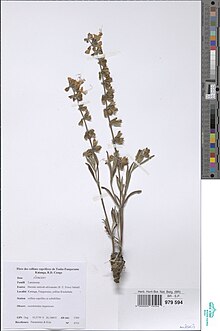| Ocimum centraliafricanum | |
|---|---|

| |
| Scientific classification | |
| Kingdom: | Plantae |
| Clade: | Tracheophytes |
| Clade: | Angiosperms |
| Clade: | Eudicots |
| Clade: | Asterids |
| Order: | Lamiales |
| Family: | Lamiaceae |
| Genus: | Ocimum |
| Species: | O. centraliafricanum |
| Binomial name | |
| Ocimum centraliafricanum R.E.Fr | |
| Synonyms | |
|
Becium homblei (De Wild) Duvign. & Plancke | |
Ocimum centraliafricanum, the copper flower or copper plant, is a perennial herb found in central Africa (DRC, Tanzania, Zambia, Zimbabwe). It is well known for its tolerance of high levels of copper in the soil, and is even used by geologists prospecting for precious metals in a process called Geobotanical prospecting.
Description
It is able to tolerate soils with copper concentrations of up to 15,000 ppm, and soils with nickel concentrations of almost 5000 ppm.
References
- Kew World Checklist of Selected Plant Families
- John W. Miller (3 March 2013). "Mining firms discover old-timers can be worth their weight in gold". The Wall Street Journal. Retrieved 5 March 2013.
- Brooks, Robert R. (1992). Noble Metals and Biological Systems: Their Role in Medicine, Mineral Exploration, and the Environment. CRC Press. p. 181. ISBN 9780849361647.
- Howard-Williams, C. (1970). "The ecology of Becium homblei in Central Africa with special reference to metalliferous soils". Journal of Ecology. 58 (3): 745–763. doi:10.2307/2258533. JSTOR 2258533.
| Taxon identifiers | |
|---|---|
| Ocimum centraliafricanum | |
This Lamiaceae article is a stub. You can help Misplaced Pages by expanding it. |